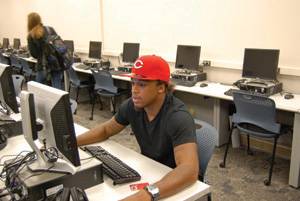Classes go from the classroom to the computer

Devin McDowell, junior in Interdiciplinary Studies, takes an online test in Carver Hall on Monday afternoon, Oct. 6, 2008. Online testing is becoming more popular among students and professors at ISU. Photo: Chris Potratz/Iowa State Daily
October 6, 2008
Online testing is replacing the standard pencil-and-paper method of testing.
With the convenience of the Internet, distance education courses are now delivered through the computer. Every year more students take online courses. According to Sloan-C, “a contorsium of institutions and organizations committed to quality online education,” 3.5 million students took at least one online course in fall 2006, nearly a 10 percent increase from fall 2005.
The advantages of online courses aren’t only for distance education students, they also apply to on-campus students, who usually take online courses to maintain a full class load or part-time job, said Gaylan Scofield, director of the Brenton Center for Agricultural Instruction and Technology Transfer, which produces many of the distance education courses through its video conferencing, DVD and streaming video capibilities.
Mina Farahbakhsh, senior in biochemistry, has taken three online courses — biochemistry, biophysics and molecular biology.
“For classes that I just have more memorization and where I don’t have to ask the professor questions, I like taking online courses,” Farahbakhsh said. “I like how I could do the work on my own time.”
Hongmeng Zhou, an Ames High School student, has been taking courses at Iowa State since 2007. While in high school, she has taken many advance placement online courses and has taken Principles of Biology I online.
“For [Principles of Biology I], I liked the online version,” Zhou said. She found taking the class online was more convenient since she had to come from the high school.
Another advantage of taking online courses is the exams. Each exam is in a computer lab and monitored.
“The exam would be available a week before the deadline, so I had about a week to take the exam,” Zhou said. The amount of time given for exams and quizzes depends on each course.
Taking the test in a computer lab, Farahbakhsh said, wasn’t different from taking it in a classroom. On the other hand, depending on the class, she was allowed to use her notes and textbooks on exams. Farahbakhsh liked being able to review lectures as many times as needed.
“Many of the tools used to deliver online education help to enhance student engagement. Lectures can be reviewed and studied further,” said David Anderson, director of the ISU Center for Distance and Online Learning. “Social interaction tools help students to exchange ideas and opinions. Evaluations of online courses have been positive, especially in relation to convenience and flexibility.”
Online courses are convenient, flexible and portable — lectures can be listened to wherever and whenever students desire.
While there are advantages, depending on the course, there can also be disadvantages, especially for a distance education student.
Distance education students are typically older, Scofield said, and have full-time jobs and know what they have to do.
An average college student goes to lecture for most of their classes because lectures aren’t repeatable. There isn’t a stronger need to attend class.
“Students who are motivated and know how to spend their time should take online courses, but if you procrastinate, it is most likely not a good idea,” Farahbakhsh said.
In an online course, on-campus students have a harder time doing well. Thirty-five percent of students taking agriculture online courses are on-campus students, but they still struggle, Scofield said. Even with a significant number, on-campus students have problems managing time.
“From the survey done at the end of each semester, distance students spend one-and-a-half to double time studying than do on-campus students,” Scofield said.






